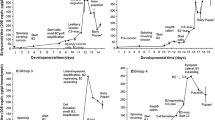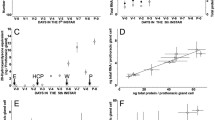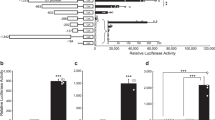Abstract
Ecdysteroids, primarily 20-hydroxyecdysone (20E) and ecdysone (E), are steroid hormones that regulate various developmental and physiological processes in insects. Commonly, immunoassays are used to quantify ecdysteroid titers of insects. However, the antibodies used in these assays react not only with 20E and E but often also with their inactive reserves and metabolites, and thus require purification before they can be quantified precisely. Here, we developed a simple cell-based method to quantify only the hormonally active ecdysteroids using newly established cells harboring the firefly luciferase gene under the control of the ecdysteroid-inducible promoter of the E75A gene of the silkworm Bombyx mori L. These cells also constitutively expressed the Renilla luciferase gene using the baculovirus ie2 promoter for internal reference. This cell-based method detected hormonally active ecdysteroids with significantly higher sensitivity than their inactive metabolites. Hemolymph ecdysteroid titers, determined using a dual luciferase assay after exposing these cells to crude extracts of B. mori larval and pupal hemolymph, agreed well with the sum of the 20E and E titers, which were quantified individually using a radioimmunoassay after they had been separated by HPLC. Thus, this method is very useful for quantifying the ecdysteroid titers of insects, particularly when the samples contain large amounts of ecdysteroid reserves and metabolites.






Similar content being viewed by others
References
Beckstead RB, Lam G, Thummel CS (2007) Specific transcriptional responses to juvenile hormone and ecdysone in Drosophila. Insect Biochem Mol Biol 37:570–578
Blais C, Blasco T, Maria A, Dauphin-Villemant C, Lafont R (2010) Characterization of ecdysteroids in Drosophila melanogaster by enzyme immunoassay and nano-liquid chromatography-tandem mass spectrometry. J Chromatogr B 878:925–932
Borst DW, O’Connor JD (1972) Arthropod molting hormone: radioimmune assay. Science 178:418–419
Champlin DT, Truman JW (1998) Ecdysteroids govern two phases of eye development during metamorphosis of the moth, Manduca sexta. Development 125:2009–2018
Clément CY, Bradbrook DA, Lafont R, Dinan L (1993) Assessment of a microplate-based bioassay for the detection of ecdysteroid-like or antiecdysteroid activities. Insect Biochem Mol Biol 23:187–193
Clever U, Clever I, Storbeck I, Young NL (1973) The apparent requirement of two hormones, α-and β-ecdysone, for molting induction in insects. Dev Biol 31:47–60
De Reggi ML, Hirn MH, Delaage MA (1975) Radioimmunoassay of ecdysone: an application to Drosophila larvae and pupae. Biochem Biophys Res Commun 66:1307–1315
Dinan L, Bourne P, Whiting P, Dhadialla TS, Hutchinson TH (2001) Screening of environmental contaminants for ecdysteroid agonist and antagonist activity using the Drosophila melanogaster B(II) cell in vitro assay. Environ Toxicol Chem 20:2038–2046
Grieneisen ML (1994) Recent advances in our knowledge of ecdysteroid biosynthesis in insects and crustaceans. Insect Biochem Mol Biol 24:115–132
Hikiba J, Ogihara MH, Iga M, Saito K, Fujimoto Y, Suzuki M, Kataoka H (2013) Simultaneous quantification of individual intermediate steroids in silkworm ecdysone biosynthesis by liquid chromatography–tandem mass spectrometry with multiple reaction monitoring. J Chromatogr B 915–916:52–56
Hill RJ, Billas IM, Bonneton F, Graham LD, Lawrence MC (2013) Ecdysone receptors: from the Ashburner model to structural biology. Annu Rev Entomol 58:251–271
Hiruma K, Riddiford LM (2009) The molecular mechanisms of cuticular melanization: the ecdysone cascade leading to dopa decarboxylase expression in Manduca sexta. Insect Biochem Mol Biol 39:245–253
Iga M, Kataoka H (2012) Recent studies on insect hormone metabolic pathways mediated by cytochrome P450 enzymes. Biol Pharm Bull 35:838–843
Imanishi S, Akiduki G, Haga A (2002) Novel insect primary culture method by using newly developed media and extracellular matrix. In: Proc 2002 Congr In Vitro Biology, Orlando, FL, USA, 26–29 June 2002, 38:16-A
Kamimura M, Saito H, Niwa R, Niimi T, Toyoda K, Ueno C, Kanamori Y, Shimura S, Kiuchi M (2012) Fungal ecdysteroid-22-oxidase, a new tool for manipulating ecdysteroid signaling and insect development. J Biol Chem 287:16488–16498
Kanamori Y, Hayakawa Y, Matsumoto H, Yasukochi Y, Shimura S, Nakahara Y, Kiuchi M, Kamimura M (2010) A eukaryotic (insect) tricistronic mRNA encodes three proteins selected by context-dependent scanning. J Biol Chem 285:36933–36944
King-Jones K, Thummel CS (2005) Nuclear receptors—a perspective from Drosophila. Nat Rev Genet 6:311–323
Kiriishi S, Rountree DB, Sakurai S, Gilbert LI (1990) Prothoracic gland synthesis of 3-dehydroecdysone and its hemolymph 3 beta-reductase mediated conversion to ecdysone in representative insects. Experientia 46:716–721
Kiuchi M, Yasui H, Hayasaka S, Kamimura M (2003) Entomogenous fungus Nomuraea rileyi inhibits host insect molting by C22-oxidizing inactivation of hemolymph ecdysteroids. Arch Insect Biochem Physiol 52:35–44
Mane-Padros D, Cruz J, Vilaplana L, Nieva C, Urena E, Belles X, Martin D (2010) The hormonal pathway controlling cell death during metamorphosis in a hemimetabolous insect. Dev Biol 346:150–160
Matsuoka T, Fujiwara H (2000) Expression of ecdysteroid-regulated genes is reduced specifically in the wing discs of the wing-deficient mutant (fl) of Bombyx mori. Dev Genes Evol 210:120–128
Mikitani K (1995) Sensitive, rapid and simple method for evaluation of ecdysteroid agonist activity based on the mode of action of the hormone. J Seri Sci Jpn 64:534–539 (in Japanese with English summary)
Miyashita M, Matsushita K, Nakamura S, Akahane S, Nakagawa Y, Miyagawa H (2011) LC/MS/MS identification of 20-hydroxyecdysone in a scorpion (Liocheles australasiae) and its binding affinity to in vitro-translated molting hormone receptors. Insect Biochem Mol Biol 41:932–937
Niwa R, Namiki T, Ito K, Shimada-Niwa Y, Kiuchi M, Kawaoka S, Kayukawa T, Banno Y, Fujimoto Y, Shigenobu S, Kobayashi S, Shimada T, Katsuma S, Shinoda T (2010) Non-molting glossy/shroud encodes a short-chain dehydrogenase/reductase that functions in the ‘Black Box’ of the ecdysteroid biosynthesis pathway. Development 137:1991–1999
Oberlander H (1972) α-Ecdysone induced DNA synthesis in cultured wing disks of Galleria mellonella: inhibition by 20-hydroxyecdysone and 22-isoecdysone. J Insect Physiol 18:223–228
Pascual N, Belles X, Delbecque JP, Hua YJ, Koolman J (1995) Quantification of ecdysteroids by immunoassay: comparison of enzyme immunoassay and radioimmunoassay. Z Naturforsch C 50:862–867
Porcheron P, Foucrier J, Gros C, Pradelles P, Cassier P, Dray F (1976) Radioimmunoassay of arthropod moulting hormone: β-ecdysone antibodies production and 125I-iodinated tracer preparation. FEBS let 61:159–162
Shinoda T, Itoyama K (2003) Juvenile hormone acid methyltransferase: a key regulatory enzyme for insect metamorphosis. Proc Natl Acad Sci USA 100:11986–11991
Shiotsuki T, Hua Y-J, Tsugane T, Gee S, Hammock BD (2005) Optimization of an enzyme-linked immunosorbent assay for ecdysteroids. J Insect Biotech Sericol 74:1–4
Shirai H, Kamimura M, Yamaguchi J, Imanishi S, Kojima T, Fujiwara H (2012) Two adjacent cis-regulatory elements are required for ecdysone response of ecdysone receptor (EcR) B1 transcription. PLoS One 7:e49348
Smith SL (1985) Regulation of ecdysteroid titer: synthesis. In: Kerkut GA, Gilbert LI (eds) Comprehensive insect physiology, biochemistry, and pharmacology, vol 7. Pergamon, Oxford, pp 295–341
Sonobe H, Masumoto T, Tokushige H, Makka T, Kawashima S, Kikuyama S (1997) Developmental changes in accumulation and metabolism of ecdysteroids in diapause eggs and non-diapause eggs of the silkworm, Bombyx mori. In: Kawashima S, Kikuyama S (eds) Advances in comparative endocrinology, vol 1. Monduzzi Editorem, Bologna, pp 185–189
Swevers L, Kravariti L, Ciolfi S, Xenou-Kokoletsi M, Ragoussis N, Smagghe G, Nakagawa Y, Mazomenos B, Iatrou K (2004) A cell-based high-throughput screening system for detecting ecdysteroid agonists and antagonists in plant extracts and libraries of synthetic compounds. FASEB J 18:134–136
Takahashi M, Kikuchi K, Tomita S, Imanishi S, Nakahara Y, Kiuchi M, Kamimura M (2003) Transient in vivo reporter gene assay for ecdysteroid action in the Bombyx mori silk gland. Comp Biochem Physiol B 135:431–437
Takeda S, Kiuchi M, Ueda S (1986) Preparation of anti-20-hydroxyecdysone serum and its application for radioimmunoassay of ecdysteroids in silkworm hemolymph. Bull Sericul Exp Stn 30:361–374 (in Japanese with English summary)
Tanaka Y, Naya S (1995) Dietary effect of ecdysone and 20-hydroxyecdysone on larval development of two lepidopteran species. Appl Entomol Zool 30:285–294
Tanaka Y, Takeda S (1993) Ultranumerary larval ecdyses of the silkworm, Bombyx mori induced by ecdysone. Naturwissenschaften 80:131–132
Tanaka Y, Yukuhiro F (1999) Ecdysone has an effect on the regeneration of midgut epithelial cells that is distinct from 20-hydroxyecdysone in the silkworm Bombyx mori. Gen Comp Endocrinol 116:382–395
Thummel CS (1996) Flies on steroids—Drosophila metamorphosis and the mechanisms of steroid hormone action. Trends Genet 12:306–310
Von Gliscynski U, Delbecque J, Böcking D, Sedlmeier D, Dircksen H, Lafont R (1995) Three new antisera with high sensitivity to ecdysone, 3-dehydroecdysone and other A-ring derivatives: production and characterization. Eur J Entomol 92:75–79
Warren JT, Gilbert LI (1986) Ecdysone metabolism and distribution during the pupal-adult development of Manduca sexta. Insect Biochem 16:65–82
Warren J, Steiner B, Dorn A, Pak M, Gilbert L (1986) Metabolism of ecdysteroids during the embryogenesis of Manduca sexta. J Liq Chromatogr 9:1759–1782
Zotti MJ, De Geyter E, Swevers L, Braz AS, Scott LP, Rouge P, Coll J, Grutzmacher AD, Lenardao EJ, Smagghe G (2013) A cell-based reporter assay for screening for EcR agonist/antagonist activity of natural ecdysteroids in Lepidoptera (Bm5) and Diptera (S2) cell cultures, followed by modeling of ecdysteroid-EcR interactions and normal mode analysis. Pestic Biochem Physiol 107:309–320
Acknowledgments
This work was supported by the Program for Promotion of Basic Research Activities for Innovative Biosciences (PROBRAIN) and Grants-in-Aid for Scientific Research 26292179 from the Ministry of Education, Culture, Sports, Science, and Technology, Japan.
Author information
Authors and Affiliations
Corresponding author
Rights and permissions
About this article
Cite this article
Kamimura, M., Matsumoto, H., Kiuchi, M. et al. Development of a cell-based assay for ecdysteroid quantification using an early ecdysteroid-inducible gene promoter. Appl Entomol Zool 49, 443–452 (2014). https://doi.org/10.1007/s13355-014-0271-1
Received:
Accepted:
Published:
Issue Date:
DOI: https://doi.org/10.1007/s13355-014-0271-1




